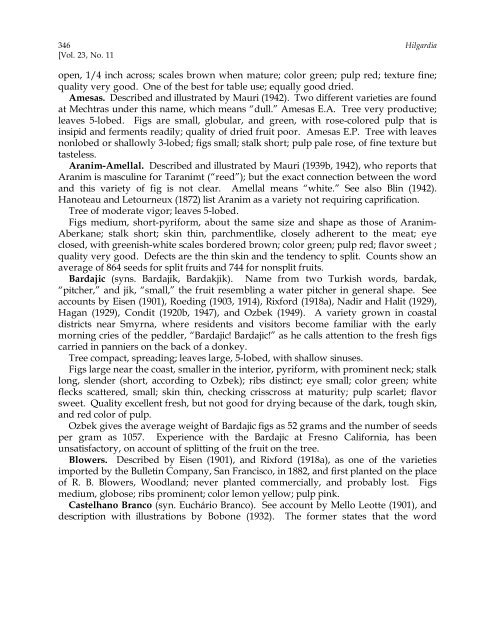Fig Varieties: A Monograph - uri=ucce.ucdavis
Fig Varieties: A Monograph - uri=ucce.ucdavis
Fig Varieties: A Monograph - uri=ucce.ucdavis
You also want an ePaper? Increase the reach of your titles
YUMPU automatically turns print PDFs into web optimized ePapers that Google loves.
346 Hilgardia<br />
[Vol. 23, No. 11<br />
open, 1/4 inch across; scales brown when mature; color green; pulp red; texture fine;<br />
quality very good. One of the best for table use; equally good dried.<br />
Amesas. Described and illustrated by Mauri (1942). Two different varieties are found<br />
at Mechtras under this name, which means “dull.” Amesas E.A. Tree very productive;<br />
leaves 5-lobed. <strong>Fig</strong>s are small, globular, and green, with rose-colored pulp that is<br />
insipid and ferments readily; quality of dried fruit poor. Amesas E.P. Tree with leaves<br />
nonlobed or shallowly 3-lobed; figs small; stalk short; pulp pale rose, of fine texture but<br />
tasteless.<br />
Aranim-Amellal. Described and illustrated by Mauri (1939b, 1942), who reports that<br />
Aranim is masculine for Taranimt (“reed”); but the exact connection between the word<br />
and this variety of fig is not clear. Amellal means “white.” See also Blin (1942).<br />
Hanoteau and Letourneux (1872) list Aranim as a variety not requiring caprification.<br />
Tree of moderate vigor; leaves 5-lobed.<br />
<strong>Fig</strong>s medium, short-pyriform, about the same size and shape as those of Aranim-<br />
Aberkane; stalk short; skin thin, parchmentlike, closely adherent to the meat; eye<br />
closed, with greenish-white scales bordered brown; color green; pulp red; flavor sweet ;<br />
quality very good. Defects are the thin skin and the tendency to split. Counts show an<br />
average of 864 seeds for split fruits and 744 for nonsplit fruits.<br />
Bardajic (syns. Bardajik, Bardakjik). Name from two Turkish words, bardak,<br />
“pitcher,” and jik, “small,” the fruit resembling a water pitcher in general shape. See<br />
accounts by Eisen (1901), Roeding (1903, 1914), Rixford (1918a), Nadir and Halit (1929),<br />
Hagan (1929), Condit (1920b, 1947), and Ozbek (1949). A variety grown in coastal<br />
districts near Smyrna, where residents and visitors become familiar with the early<br />
morning cries of the peddler, “Bardajic! Bardajic!” as he calls attention to the fresh figs<br />
carried in panniers on the back of a donkey.<br />
Tree compact, spreading; leaves large, 5-lobed, with shallow sinuses.<br />
<strong>Fig</strong>s large near the coast, smaller in the interior, pyriform, with prominent neck; stalk<br />
long, slender (short, according to Ozbek); ribs distinct; eye small; color green; white<br />
flecks scattered, small; skin thin, checking crisscross at maturity; pulp scarlet; flavor<br />
sweet. Quality excellent fresh, but not good for drying because of the dark, tough skin,<br />
and red color of pulp.<br />
Ozbek gives the average weight of Bardajic figs as 52 grams and the number of seeds<br />
per gram as 1057. Experience with the Bardajic at Fresno California, has been<br />
unsatisfactory, on account of splitting of the fruit on the tree.<br />
Blowers. Described by Eisen (1901), and Rixford (1918a), as one of the varieties<br />
imported by the Bulletin Company, San Francisco, in 1882, and first planted on the place<br />
of R. B. Blowers, Woodland; never planted commercially, and probably lost. <strong>Fig</strong>s<br />
medium, globose; ribs prominent; color lemon yellow; pulp pink.<br />
Castelhano Branco (syn. Euchário Branco). See account by Mello Leotte (1901), and<br />
description with illustrations by Bobone (1932). The former states that the word














![Fig Trees in North Carolina [Archive] - IDigMyGarden ... - Figs 4 Fun](https://img.yumpu.com/26905320/1/190x245/fig-trees-in-north-carolina-archive-idigmygarden-figs-4-fun.jpg?quality=85)

